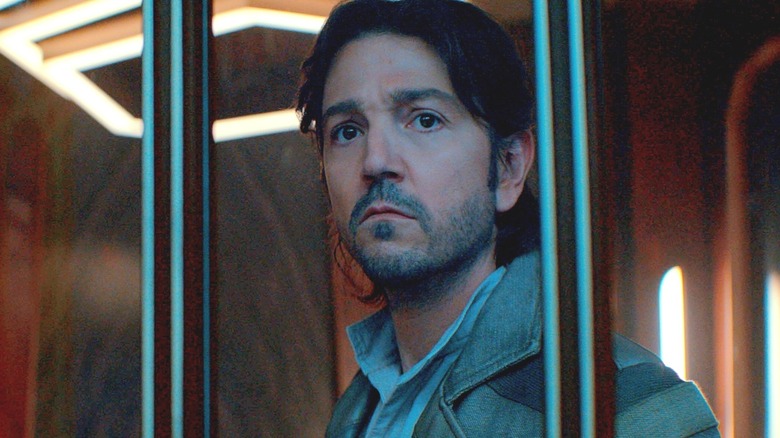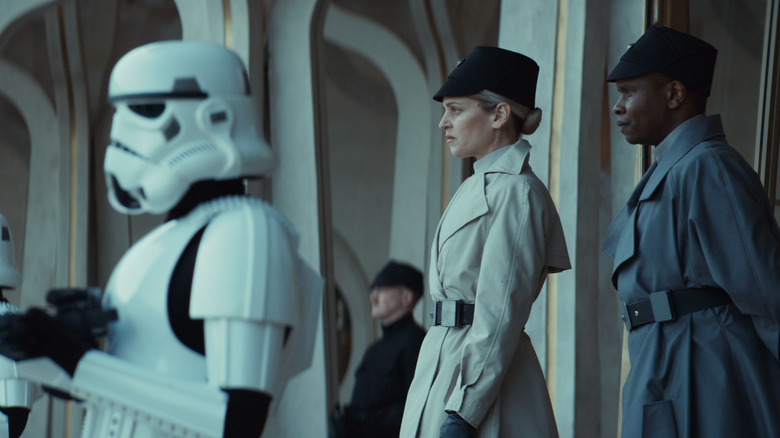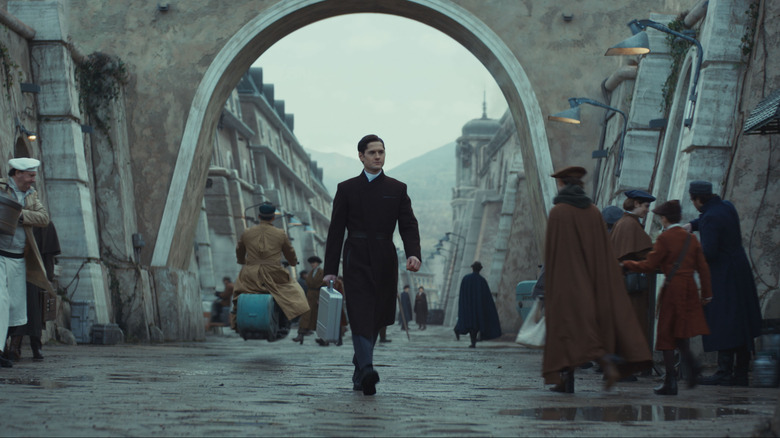Andor Season 2 Lets Us See What TV Is Like In The Star Wars Universe, And It's Amazing
The "Star Wars" franchise has one of the biggest and most detailed fictional universes out there, with the first movie introducing a world that was both recognizable and entirely alien. Sure, we had a princess, a cowboy, a wizard, an empire, and a rebellion, but it was firmly an alien world that felt unlike ours in most ways. And yet, in time, the franchise started looking more and more familiar. The way the Ewoks fought the Empire in "Return of the Jedi" was unequivocally inspired by the Viet Cong, and the prequels took this to a new level, featuring an American diner in space, an opera house, a NASCAR race, and more.
This is not a bad thing, necessarily. The prequels were more specific in their commentary and used familiar imagery to tell a story of a very fictional world that nevertheless can suffer the same political issues ours does. This brings us to "Andor," the absolute timeliest "Star Wars" story. This is the franchise at its most real, with a story that could easily take place in our world, and is absolutely unsubtle in the way it addresses our present-day reality — even while still featuring stormtroopers and TIE Fighters. Throughout season 1, "Andor" blurred the lines between the galaxy far, far away and our own. There was fun stuff like Space Miami (aka Niamos), but also the way the show turned the cartoonish evil of the empire into recognizably mundane bureaucracy.
In season 2, Tony Gilroy and his team double down on making "Andor" a very real and timely story that just happens to be set a long time ago, in a galaxy far, far away. "The Clone Wars" had already given us an on-screen look at the "Star Wars" equivalent of the internet — the HoloNet and its many entertainment uses. In episode 5, "Andor" was so devoted to showing us the slower, more day-to-day aspects of "Star Wars" that it just gave us ... daytime TV. That's right, in the middle of talks about genocide, mentions of massacres, and a very French-coded resistance, we got a glimpse of what television looks like in the galaxy far, far away. It's as weird as you'd expect.
The Imperial machine reaches as far and wide as... daytime TV
Episode 5 is all about the Ghorman Resistance, which we know to be more than just partially engineered by the Empire in order to justify killing everyone on the planet in order to mine for unlimited power. Suddenly, however, we get a new chapter in the most delightfully deranged sitcom in the "Star Wars" universe — the Syril's mom power-hour! That's right, we get yet another awkward mother-son meal, only this time they have a TV on in the background, and we get a glimpse of what people in "Star Wars" watch while they eat.
Turns out, it looks a lot like our own daytime TV! We get a morning show complete with hosts (including Ruby Wax!) dressed like the campiest "Hunger Games" characters. What do they talk about? Why, celebrity gossip, of course. One of the hosts mentions a senatorial party, and they immediately joke about now caring about politics, but loving parties involving politicians, because of their outfits. It's a short scene, but it serves to paint a picture of the kind of bread and circuses the Empire uses to keep the populace distracted. We know that the government is in the midst of planning a planet-wide genocide, yet all the TV hosts can talk about is celebrity outfits. Again, it's extremely timely and also timeless: fascist propaganda and distraction tactics at work.
But that's not all. For an entirely different side of TV in the "Star Wars" universe, we later get a blink-and-you-miss-it shot of two Imperial guards distracted on the job because they're watching a broadcast of the greatest sporting event in the entire galaxy — podracing! Does that mean they have the "Star Wars" equivalent of Netflix's F1 docu-series "Drive to Survive?" Are podracers big celebrities in-universe? Is Sebulba still a big star during the Imperial era? Perhaps Ratts Tyerell is regarded as a legend, like Ayrton Senna is in our universe.
What's TV like under the Empire?
"Star Wars" is great when it is a mystified fantasy with allusions to events, people, and places we never see (like Obi-Wan mentioning the Clone Wars in the original movie, or Luthen having a Rakatan Empire necklace in "Andor"). It's great when all we get are archetypes straight out of a fairy tale: heroes fighting comically big odds.
But shows like "Andor," like "Rebels" or "Clone Wars" show that the franchise is just as great when we see the minutiae of the galaxy, and learn seemingly unnecessary or silly details about how life is. Dexter Jettster's diner is a cool little nod to George Lucas' "American Graffiti," and it is also a nice contrast to the seediness of the cantina on Mos Eisley.
The inclusion of daytime TV as an extension of Imperial propaganda makes the vastness of the Empire feel more connected. It also contrasts what people on Coruscant care about (or are forced to care about) with the priorities of people on the Outer Rim. The capital cities of dictatorships are usually the most devout and the most ignorant to the atrocities. "Andor" shows how that works — how the distraction machine works to keep people from realizing the truth.


